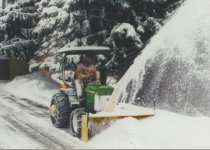Conventional wisdom would say you need ballast.
How much weight per horsepower do you have now, excluding implements? My 30 hp JD 790 would only have about 70 lb/hp without ballast. I think most applications need to get up over 100 lb/hp excluding implements. Of course the ground surface quality matters too, but I think the 100 lb/hp min is probably in the ballpark for most applications. Horsepower tends to make them slip, weight (friction) tends to make them grip, you have to have a balance.
Don't count on your loader offering any assistance, most of it's weight is in front of the front wheels and hurts more than it helps. I plan to add about 1000 pounds of wheel weights (home-made). That will give me just about 103 lb/hp before adding any implements. If that isn't enough, I could add about another 600 pounds by filling my R4s. That would get me up to 123 lb/hp.
The best place to add weight is at the wheels themselves. There is no point adding 50% more load to my wheel bearings and chassis when I don't have to. Weight on the wheel only stresses the wheel rim and just sits on the ground. Sure, I know the bearings can survive the load, but if I can get the job done at the wheels, that's my preference.
I have a 537 pound boxblade that will help with ballast when I'm lifting with the FEL, but that doesn't help when I'm dragging the boxblade on the ground. Actually I will get better rear traction for the boxblade by taking the FEL off.
Cheapest commercially available steel I've seen is weightlifting weights. Walmart had 45 pound weights that were about 15" diameter and 1.5" thick, $21 each, $0.47/lb. I could fit six of those in each of my 15-19.5 R4s, for 270 pounds each wheel. You can get a kit from EZ-Weight to attach a 1" threaded rod on the wheel for mounting weightlifting weights, but personally I decided that I would just drill the weightlifting weights for the standard wheel-weight bolt pattern. I've also heard of 50 lb weights that are thinner than this, but the WalMart deal is the best price I've found. Tractor-branded wheel weights may cost about $1 to $2 /lb.
Of course you can also fill the tires. My R4s would hold about 29 gallons at 75% full (to keep the valve above water). Non-corrosive "Rim-Guard" costs about $3/gal around here, and is about 11lb/gal, for a total of 319 pounds per wheel at $0.27/lb. Water is free at about 8 pounds/gal, but would freeze, so some put glycol in, but if you have to drain it out, that's a lot of poisonous glycol to drain someplace and keep the animals out of it. Windshield washer fluid is about $0.99/gal at WalMart, rated anywhere from 0degF, -20degF, and some even -50degF, but lighter than water, maybe about 7lb/gal, for about $0.14/lb.
In my case I found a 1500 pound plate of 3/8" steel that I plan to cut up into 16" disks. Flat plate like that adds up to more weight per wheel because it is completely flat. Weightlifting weights have lots of recesses (raised lettering, recessed surfaces, hole in the middle) so they don't give you as much weight density. I even thought about filling the holes and recesses with molten lead before drilling and stacking them...
The flat plate of steel won in the end for me. It is going to cost me a bit to cut it up into disks, but gives me the best weight per wheel without filling the tires.
That pretty well summarizes my thought process about tractive ballast.

